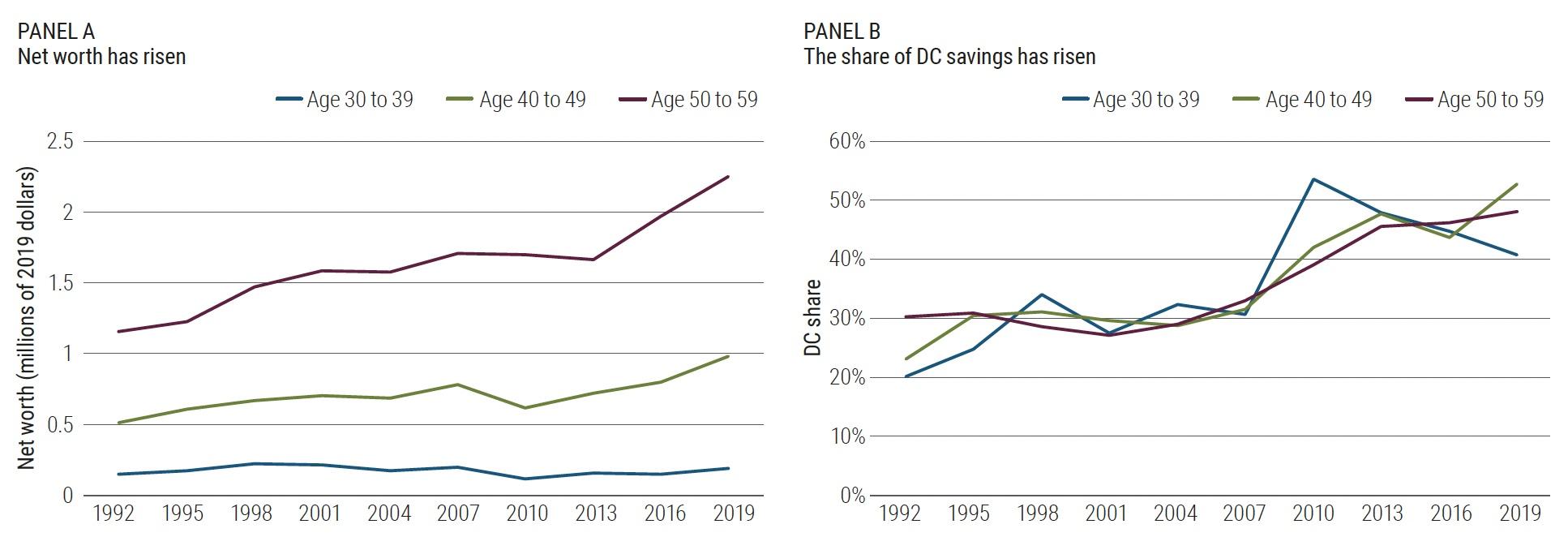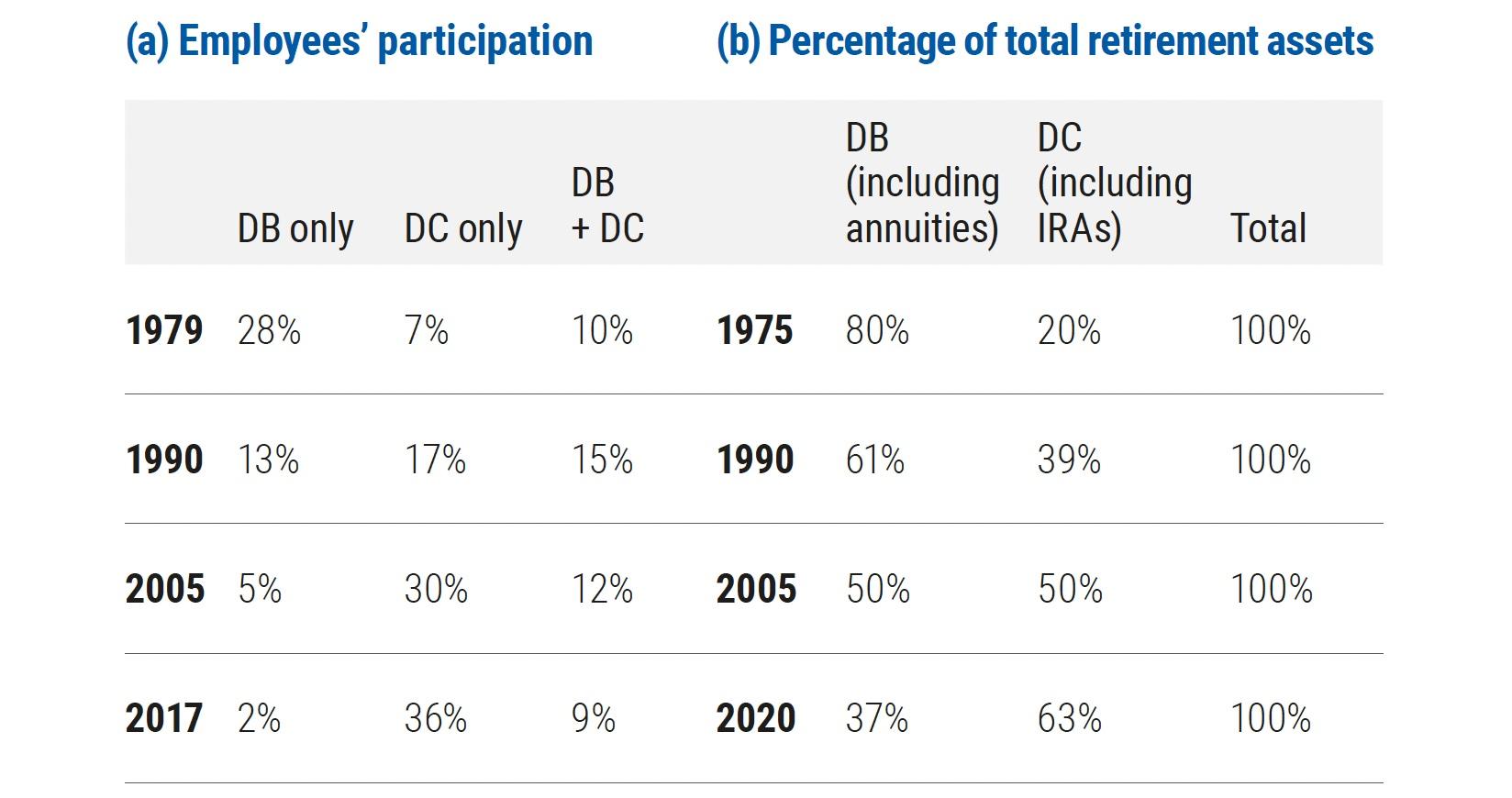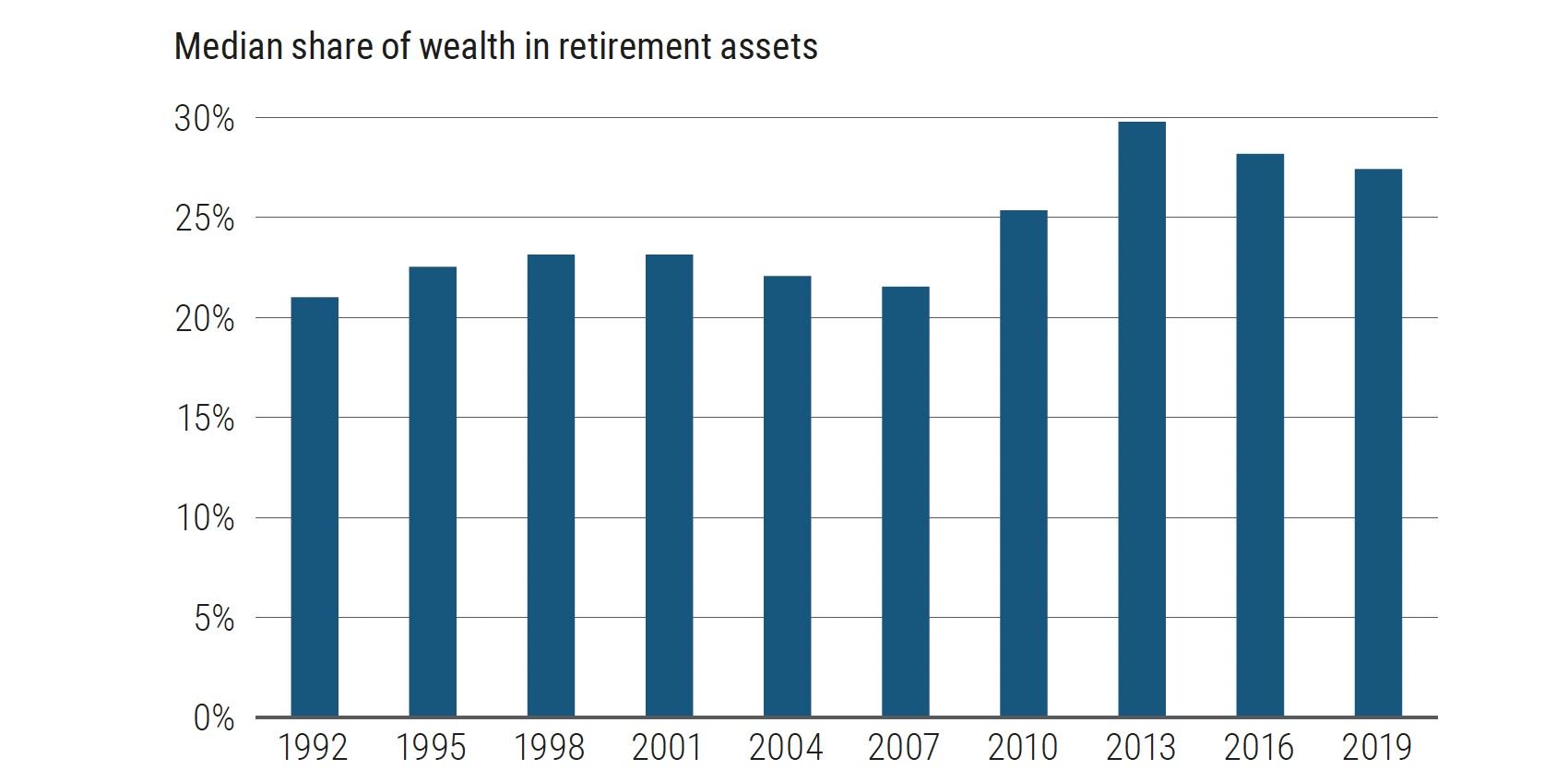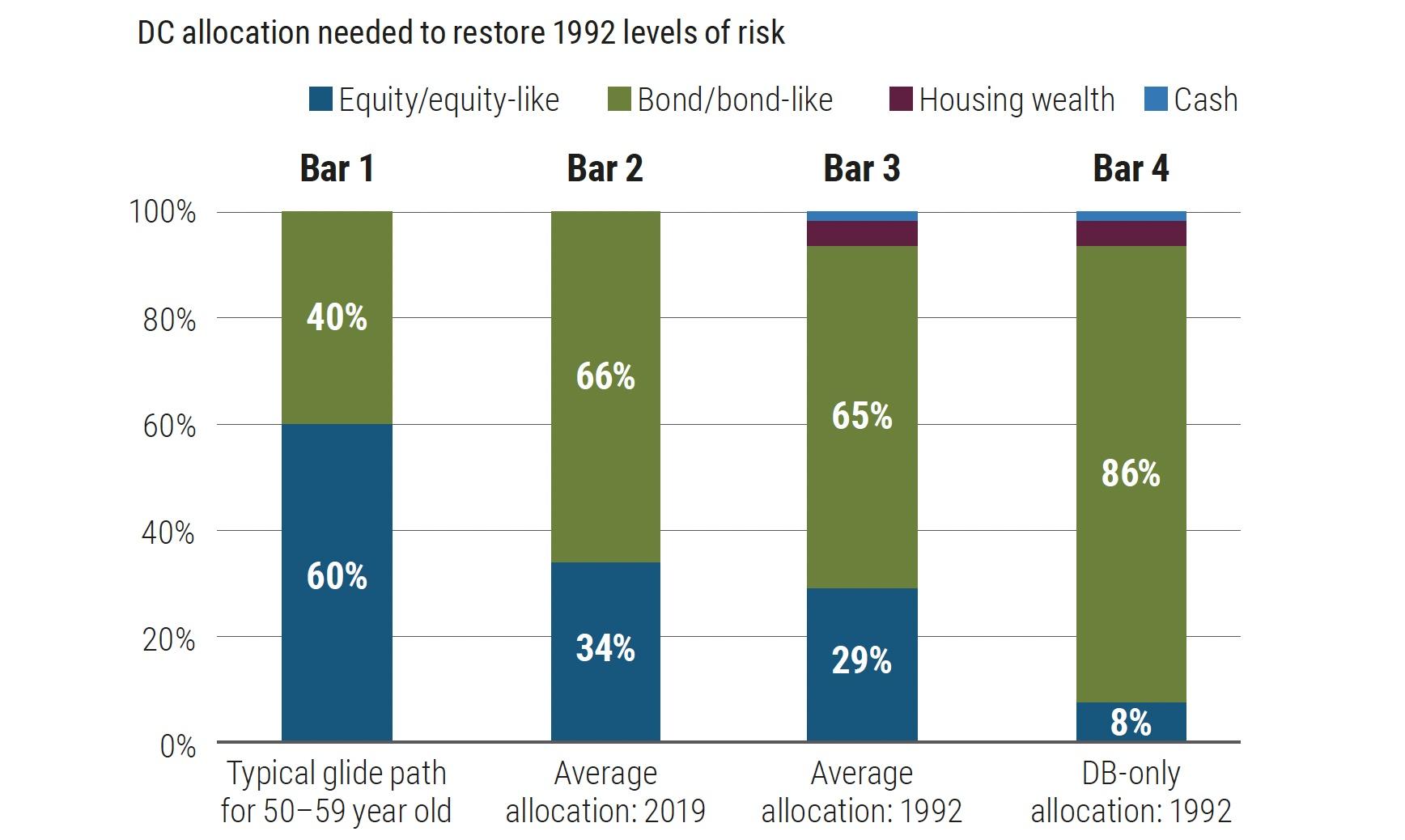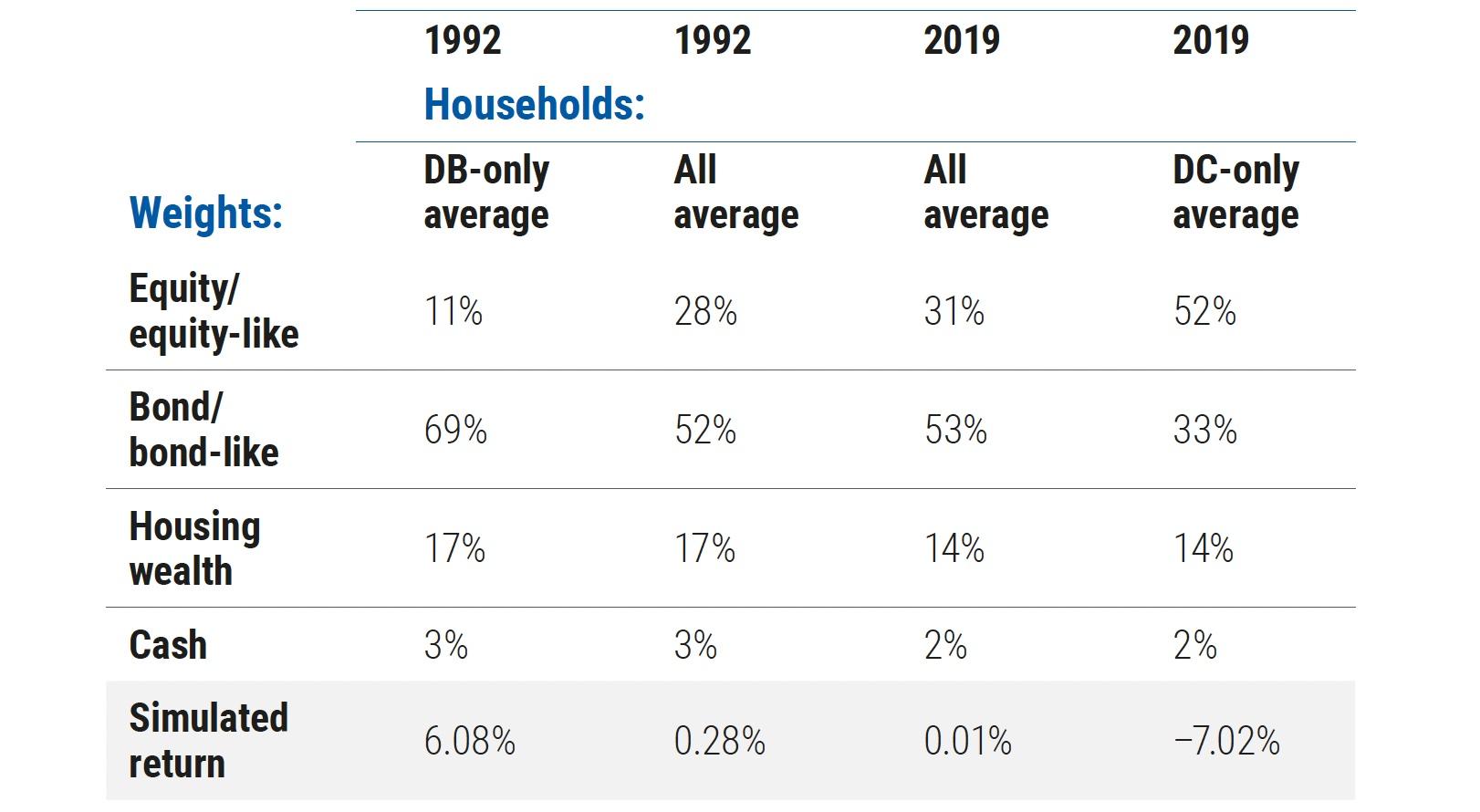As private sector defined benefit (DB) plans have waned in the US, defined contribution (DC) plans have emerged as a crucial component of retirement savings. Established in 1978, plans such as 401(k)s let employees defer taxes on their contributions and allow their employers to make matching contributions.
Over the years, Congress has strengthened DC plans by broadening access, boosting contribution limits, and implementing behaviourally based nudges such as auto- enrolment and auto-escalation. As a result, participation rates and contribution levels have risen. In particular, target date funds (TDFs), which were allowed as qualified default investments in 2006, now dominate inflows, offering professionally managed glide paths designed to reduce risk as retirement approaches. These enhancements were well-meaning and fruitful. Yet, in a gradual and little-noticed trend, rising DC balances and elevated equity exposures in TDFs have meaningfully increased the risk profile of household net worth.
As Figure 1 shows, household net worth has increased, particularly among older households (Panel A), and DC savings represent a growing share of household net worth (Panel B).
Figure 1 The dominance of retirement wealth
Source: PIMCO, Kuhn et al. (2020) and the 2019 Federal Reserve Survey of Consumer Finances, the most recent data available.
Note: The sample represents households in the 50th to 90th percentiles of the overall wealth distribution. Net worth is per household and shown in millions of 2019 dollars.
Note that Figure 1 depicts only households within the 50th to 90th percentiles of the overall wealth distribution. This is for several reasons. Households below the median possess minimal wealth, often hovering around or precisely at zero. Within the top 50%, who own most of the assets, the majority (excluding the 90th to 100th percentiles of the overall wealth distribution) hold most of their wealth in just two areas: equity in their primary residence and retirement savings, including both DB and DC assets. In contrast, the top 10% of households tend to have more complex balance sheets, including nontrivial investments outside of retirement accounts and wealth in private businesses.
For this ‘middle wealth’ group that we focus on, retirement wealth is a key risk. For the average household in this group, nonretirement wealth – such as small business wealth, private investments, life insurance, certificates of deposit, brokerage accounts, money market instruments, and even chequing or savings accounts – makes up less than 20% of total wealth across all ages.
As individuals age, their retirement balances tend to grow faster relative to the value of their primary residence. In addition, the composition of their wealth changes dramatically over time (see Figure 2).
Figure 2 Allocations to retirement assets have grown faster than those to nonretirement assets
Source: PIMCO, Kuhn, et al. (2020) and the 2019 Survey of Consumer Finances.
Note: The boxes represent the interquartile range (25th to 75th percentiles), and the whiskers the 5th to 95th percentiles, of each allocation type.
Retirement wealth: Evolving from DB to DC
These trends show the slow but significant shift in how Americans save for retirement. In the 1950s and 1960s, most asset-owning households had DB pension plans, which from the employee’s perspective provided a relatively safe stream of bond-like payments in retirement. Starting in the 1970s, legal and institutional developments encouraged the creation and expansion of self-managed DC plans (Employee Benefits Research Institute 2018), which by the 1990s had eclipsed DB plans as the major locus of retirement wealth (Pacholok and Zaya 2022).
As Table 1 shows, this transformation continues today. The remaining DB plans, mostly in the public sector, cover just 11% of employees and represent only 37% of total retirement assets, a decline from 38% and 80%, respectively, in 1979. In contrast, DC plans now cover 45% of workers and hold 63% of total retirement assets, up from 17% and 20%, respectively, in 1979.
Table 1 The shift from DB to DC
Source: EBRI and ICI as of 2022, Bodie et al. (1988), and Munnell (2006).
Retirement wealth stored in DC plans is generally viewed as riskier than that in DB plans. After all, DC savings are driven by the amount of savings, the way they’re allocated and the market environment during a participant’s lifetime. Unlike the bond-like benefits of DB plans, DC assets are often defaulted into equity-heavy (and thus more volatile) investments, especially for younger participants. In 2023, for example, the typical target date fund has an equity allocation of 90% at age 30, falling only to 74% at age 50 (Pacholok and Zaya 2022).
Increase in allocation to retirement wealth
Paradoxically, the rise in risk results from one of the most successful behavioural interventions in finance: the advent of auto-enrollment and auto-escalation of workers in 401(k) plans (Benartzi and Thaler 2013, Miller 2022), Congress approved auto-enrollment in 1998; today, just over half of firms automatically enroll employees in their 401(k) plans and automatically invest their contributions in qualified default investments. These approaches have increased participation rates and balances (Madrian and Shea 2001), often far more successfully than explicit financial incentives, such as an employer’s contribution match rate (Madrian 2012).
Figure 3 shows the increase in the share of wealth driven by retirement assets, largely concentrated in DC accounts. These assets’ share of middle-wealth households’ balance sheets increased steadily by 6–8 percentage points, or approximately 30–40%,
over the past three decades. Not only do retirement accounts tend to grow as people age, they have become relatively larger over time.
Figure 3 Retirement wealth has grown in importance
Source: PIMCO, Kuhn et al. (2020) and the 2019 Survey of Consumer Finances.
Note: The sample represents middle-wealth households with heads between the ages of 30 and 60.
Of course, high average balances can obscure significant concerns in parts of the distribution. Balances and participation rates remain low for many groups (Gale et al. 2005), and there is notable dispersion in retirement wealth (Browne et al. 2022). Similarly, many households have concentrations in retirement assets much higher than this average, yet the amount of their retirement wealth rarely affects the default (and thus the prevailing) investment allocation for DC participants.
Quantifying the evolution of risk
The shift from DB to DC has given participants with large retirement balances a radically different risk profile from their parents’. Although an individual’s TDF glide path may reduce risk with age, in the aggregate this reduction is more than offset by the rising share of financial assets in total wealth and the increased weight of DC relative to DB plans. The growing share of wealth in retirement accounts as households age suggests that embedded market risks may be greatest precisely when people are least prepared to handle them.
Using asset information from the Survey of Consumer Finances and historical covariance data, we calculated the evolution and sources of volatility in household net worth for the average 40- to 49-year-old household in the 50th–90th percentiles of net worth (see Figure 4). From 1992 to 2019, the typical household in this cohort saw net worth volatility increase by 40%, from about 5.5% to 7.5%, on an annualised basis.
Figure 4 Rising risks in retirement assets and household net worth
Source: PIMCO, Kuhn, et al. (2020) and the 2019 Survey of Consumer Finances.
Note: Data represents 40- to 49-year-old households with wealth in the 50th to 90th percentile of the distribution. Volatility contributions are calculated as in Menchero and Davis (2011).
Importantly, this shift in risk is not exclusively due to the transition from defined benefit to defined contribution plans. If we repeat the analysis for account holders with only DC balances, we see an increase in risk of nearly 20% (from 11% to 13% annualised) as their retirement wealth grew as a share of their total assets. Based on the 2019 Survey of Consumer Finances, we estimate that more than 90% of the overall risk for a middle- income, middle-aged household came from the DC component of their assets. This effect is exacerbated for households with higher DC balances or greater savings rates that will translate to higher future balances.
An asset allocation view of the great risk shift
The risk shifts that have emerged from the DB-to-DC transition and the increase in participation and contribution rates are substantial. To understand the evolution, we can examine the allocation in DC accounts needed to restore their 1992 asset allocations and past risk profiles. Figure 5 illustrates this concept using four synthetic households, each with a unique allocation.
Figure 5 Consistent risk profiles over time require distinct allocations
Source: PIMCO, Kuhn et al. (2020) and the 2019 Survey of Consumer Finances
To better understand Figure 5, consider that:
- A helpful reference point is a typical DC-only household in its 50s in 2019 (because most individuals are in either a DB or a DC plan). Its average asset allocation across the median TDF’s glide path is 60% stocks and 40% bonds, as shown in Bar 1.
- To match the allocation and risk exposure of the hypothetical 50- to 60-year-old household with the average balance sheet in 2019 (i.e. averaged across both DB and DC households, and the few with both), the glide path would need to be almost completely reversed at 66% bonds and 34% equities, as shown in Bar 2.
- To go further and return to the allocation and risk levels of the prior generation – a 1992 household with the average balance sheet – we would need to impose a still larger allocation shift, with equities down to 29% and a modest allocation to housing and cash, as shown in Bar 3.
- Finally, to replicate a risk exposure akin to the prior generation’s average DB-only participant from 1992, the DC account of today would need to have 86% invested in bonds and only 8% in equities, as Bar 4 shows.
These statistics capture the extent to which secular trends have amplified the risk exposures in the typical retirement portfolio. Of course, changes of this magnitude would have resulted in different historical adverse tail risk experiences, and here the changes are potentially even more pronounced.
To starkly underline this point, we can compute the total returns to these hypothetical retirement portfolios that would have materialised in the most notable left tail of recent times, the global financial crisis (GFC), from the third quarter of 2007 to the third quarter of 2010 (see Table 2). This time frame corresponds to a flight to safety, with a large equity drawdown of 20%, a substantial housing wealth drawdown of 9% and fixed income gains of 14%. In addition, real rates were depressed and inflation expectations remained low.
Table 2 Simulated returns to sample allocations in the GFC, 3Q 2007–3Q 2010
Note: Simulated returns are shown for illustrative purposes only. Total nominal returns are proxied by the S&P 500 for equity and equity-like exposures, the Bloomberg US Aggregate Bond Index for bond and bond-like assets, the Case- Shiller 20 City Composite Home Price Index plus a 4% rental yield for housing wealth, and zero for cash. Past performance is not indicative of future results. Indexes are unmanaged, and it is not possible to invest directly in an index. Indexes do not take into account fees, which would reduce returns.
If its employer and pension remained solvent, a DB-only household with a 1992-like allocation would have been well protected from downturns in risk assets during the GFC: given the household’s heavy allocation to bonds and bond-like assets, its overall three-year return would have been 6%. In contrast, the average household’s portfolio of 1992 or 2019 would not have fared so well. With a lower bond exposure, it would have seen an essentially flat wealth trajectory in nominal terms and a decline in real terms.
The hypothetical 2019 DC-only household would have fared worst: with a relatively light 33% allocation to bonds and much larger weights of risk assets, it would have experienced a nominal return of -7%.
Smoothing the roller coaster ride
The data show that most asset-owning American households engage in meaningful wealth accumulation – but that the way they do it has been changing over time. Rising incomes, combined with behavioural nudges that increase participation and generate steady contributions, have afforded many households a retirement balance larger than anything their parents or grandparents enjoyed. But the growth of self-managed DC accounts and their generally higher equity risk means that while today’s nest eggs are larger, they are also more vulnerable to cracks.
To be clear, while we do not advocate a return to the bond-heavy portfolios of yore, other investment approaches might mitigate some of this effect. Starting from a low base in the early 1990s, the initial increase in equity weights added little risk. But growing equity concentrations and the rise in the relative size of retirement assets on households’ balance sheets may now make equity-heavy target date allocations less appealing. Risk could be reduced by extending duration in the remaining bond-like assets or implementing hedges against large equity drawdowns, particularly for the oldest households with the largest balances. In addition, allocations could be adjusted based on savings rates or by making allowances for households’ other risk assets, such as housing, and including hedges against rare but large and potentially devastating tail risks, such as equity sell-offs.
Nonetheless, many TDFs appear to be trending in the opposite direction, raising equity exposure for participants even more. Research shows that median target date allocations were 11 percentage points higher at the outset and 3 percentage points higher at retirement in 2021 than they were in 2011 (Pacholok and Karen Zaya 2022). That seems difficult to justify in the context of these trends.
References
Benartzi, S and R H Thaler (2013), “Behavioral Economics and the Retirement Savings Crisis,” Science, 8 March.
Bodie, Z, A J Marcus, and R C Merton (1988), “Defined Benefit versus Defined Contribution Pension Plans: What are the Real Trade-offs?”, in Z Bodie, J B Shoven, and David A Wise (eds), Pensions in the U.S. Economy, University of Chicago Press.
Browne, E, S Klein, S Sapra, and A M Taylor, “Asset Allocation Implications of Household Diversity,” PIMCO In Depth, December.
Employee Benefits Research Institute (2018), “Fast Facts: History of 401(k) Plans: An Update”, 5 November.
Gale, W G, J M Iwry, and P R Orszag (2005), “The Automatic 401(k): A Simple Way to Strengthen Retirement Savings,” Brookings Working Paper, 1 March.
Jordà, O, M Schularick, and A M Taylor (2017), “Macrofinancial History and the New Business Cycle Facts,” in M Eichenbaum and J A Parker (eds), NBER Macroeconomics Annual 2016, Vol. 31, University of Chicago Press.
Klein, S and A M Taylor (2023), “Nudged Onto the Roller Coaster”, PIMCO In Depth, October.
Kuhn, M, M Schularick, and U I Steins (2020), “Income and Wealth Inequality in America, 1949–2016", Journal of Political Economy.
Madrian, B C (2012), “Matching Contributions and Savings Outcomes: A Behavioral Economics Perspective,” NBER Working Paper No. 18220.
Madrian, B C and D F Shea (2001), “The Power of Suggestion: Inertia in 401(k) Participation and Savings Behavior,” Quarterly Journal of Economics, November.
Menchero, J and B Davis (2011), “Risk Contribution Is Exposure Times Volatility Times Correlation: Decomposing Risk Using the X-Sigma-Rho Formula,” Journal of Portfolio Management, Winter.
Miller, S (2022), “401(k) Auto-Enrollment Proves Popular”, SHRM, April.
Munnell, A (2006), “Employer–Sponsored Plans: The Shift from Defined Benefit to Defined Contribution”, in G L Clark, A Munnell, and J M Orszag (eds), The Oxford Handbook of Pensions and Retirement Income, Oxford University Press.
Pacholok, M and K Zaya (2022), “2022 Target-Date Strategy Landscape,” Morningstar, 23 March.

